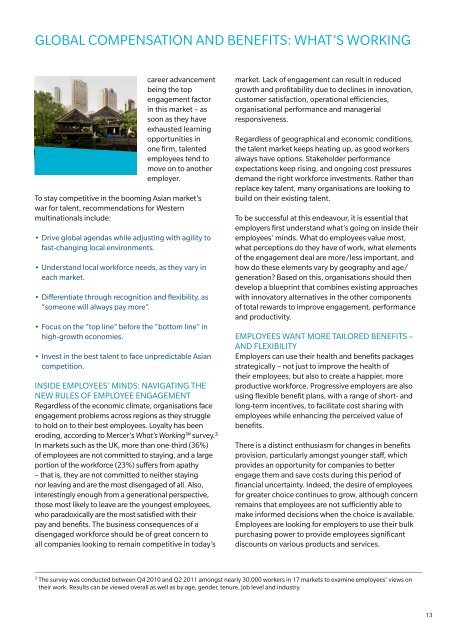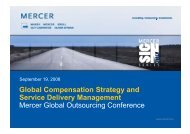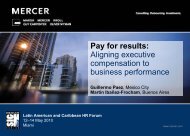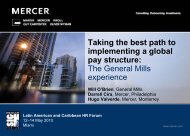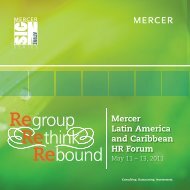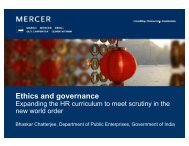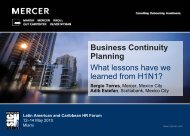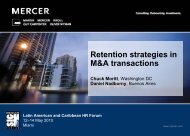A SERIES OF ARTICLES FRoM THE 2011 EMEA CoMPENSATIoN ...
A SERIES OF ARTICLES FRoM THE 2011 EMEA CoMPENSATIoN ...
A SERIES OF ARTICLES FRoM THE 2011 EMEA CoMPENSATIoN ...
You also want an ePaper? Increase the reach of your titles
YUMPU automatically turns print PDFs into web optimized ePapers that Google loves.
GLOBAL COMPENSATION AND BENEFITS: WHAT’S WORKING<br />
career advancement<br />
being the top<br />
engagement factor<br />
in this market – as<br />
soon as they have<br />
exhausted learning<br />
opportunities in<br />
one firm, talented<br />
employees tend to<br />
move on to another<br />
employer.<br />
To stay competitive in the booming Asian market’s<br />
war for talent, recommendations for Western<br />
multinationals include:<br />
• Drive global agendas while adjusting with agility to<br />
fast-changing local environments.<br />
• Understand local workforce needs, as they vary in<br />
each market.<br />
• Differentiate through recognition and flexibility, as<br />
“someone will always pay more”.<br />
• Focus on the “top line” before the “bottom line” in<br />
high-growth economies.<br />
• Invest in the best talent to face unpredictable Asian<br />
competition.<br />
INSIDE EMPLOYEES’ MINDS: NAVIGATING <strong>THE</strong><br />
NEW RULES <strong>OF</strong> EMPLOYEE ENGAGEMENT<br />
Regardless of the economic climate, organisations face<br />
engagement problems across regions as they struggle<br />
to hold on to their best employees. Loyalty has been<br />
eroding, according to Mercer’s What’s Working survey. 3<br />
In markets such as the UK, more than one-third (36%)<br />
of employees are not committed to staying, and a large<br />
portion of the workforce (23%) suffers from apathy<br />
– that is, they are not committed to neither staying<br />
nor leaving and are the most disengaged of all. Also,<br />
interestingly enough from a generational perspective,<br />
those most likely to leave are the youngest employees,<br />
who paradoxically are the most satisfied with their<br />
pay and benefits. The business consequences of a<br />
disengaged workforce should be of great concern to<br />
all companies looking to remain competitive in today’s<br />
market. Lack of engagement can result in reduced<br />
growth and profitability due to declines in innovation,<br />
customer satisfaction, operational efficiencies,<br />
organisational performance and managerial<br />
responsiveness.<br />
Regardless of geographical and economic conditions,<br />
the talent market keeps heating up, as good workers<br />
always have options. Stakeholder performance<br />
expectations keep rising, and ongoing cost pressures<br />
demand the right workforce investments. Rather than<br />
replace key talent, many organisations are looking to<br />
build on their existing talent.<br />
To be successful at this endeavour, it is essential that<br />
employers first understand what’s going on inside their<br />
employees’ minds. What do employees value most,<br />
what perceptions do they have of work, what elements<br />
of the engagement deal are more/less important, and<br />
how do these elements vary by geography and age/<br />
generation Based on this, organisations should then<br />
develop a blueprint that combines existing approaches<br />
with innovatory alternatives in the other components<br />
of total rewards to improve engagement, performance<br />
and productivity.<br />
EMPLOYEES WANT MORE TAILORED BENEFITS –<br />
AND FLEXIBILITY<br />
Employers can use their health and benefits packages<br />
strategically – not just to improve the health of<br />
their employees, but also to create a happier, more<br />
productive workforce. Progressive employers are also<br />
using flexible benefit plans, with a range of short- and<br />
long-term incentives, to facilitate cost sharing with<br />
employees while enhancing the perceived value of<br />
benefits.<br />
There is a distinct enthusiasm for changes in benefits<br />
provision, particularly amongst younger staff, which<br />
provides an opportunity for companies to better<br />
engage them and save costs during this period of<br />
financial uncertainty. Indeed, the desire of employees<br />
for greater choice continues to grow, although concern<br />
remains that employees are not sufficiently able to<br />
make informed decisions when the choice is available.<br />
Employees are looking for employers to use their bulk<br />
purchasing power to provide employees significant<br />
discounts on various products and services.<br />
3<br />
The survey was conducted between Q4 2010 and Q2 <strong>2011</strong> amongst nearly 30,000 workers in 17 markets to examine employees’ views on<br />
their work. Results can be viewed overall as well as by age, gender, tenure, job level and industry.<br />
13


